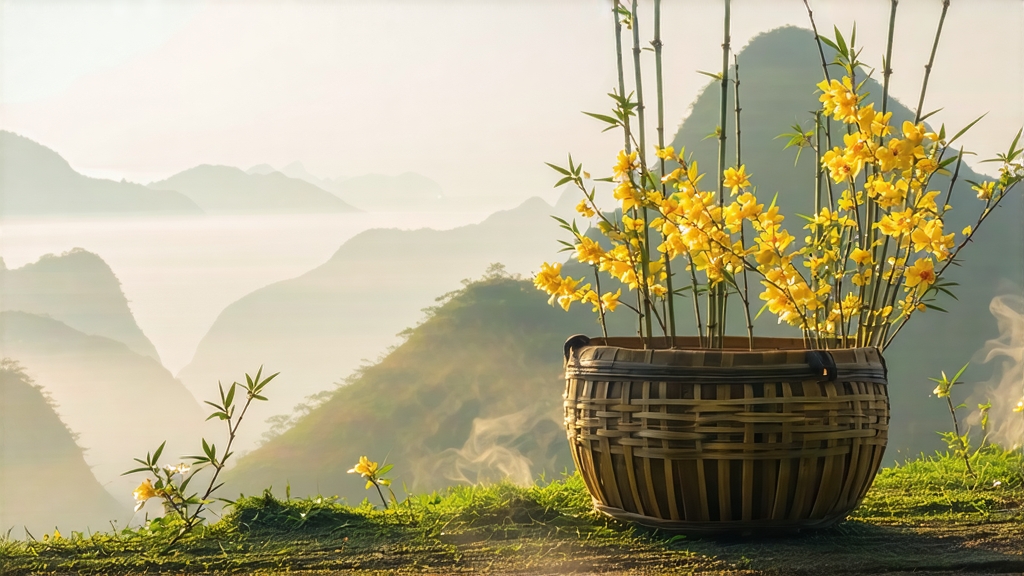
Tucked high above the Sichuan basin, where perpetual cloud veils the Min River gorge, lies Meng Ding Mountain, the cradle of the world’s oldest recorded tea garden. It was here, in a mist that never quite lifts, that Buddhist monks of the Western Han dynasty first coaxed a shy yellow bud from the camellia sinensis shrub. The bud, plucked before the Qingming festival when nights are still cold, became known as Meng Ding Huang Ya—“the yellow sprout of Meng Ding.” For thirteen centuries it rode in bamboo cages along the Tea-Horse Road, paid as imperial tribute to Tang, Song and Ming courts, then slipped into near-oblivion when green tea fashions swept China. Today fewer than three thousand kilos leave the mountain each spring, making it the rarest of China’s six tea families, yet every leaf still carries the perfume of Han dynasty pine smoke and the soft luminosity of mountain fog.
Botanically, Meng Ding Huang Ya is a landrace population of sinensis var. sinensis, shorter in internode and ivory in petiole, adapted to 1,200 m of elevation and 85 % humidity. Growers distinguish three picking grades: Ming-qian single bud (jin ya, “golden sprout”), pre-rain one bud & one leaf (yu ya, “jade sprout”), and Gu-yu one bud & two leaves (cu ya, “coarse sprout”). Each grade is processed separately, but all undergo the defining “sealed yellowing” (men huang) that moves the tea out of the green spectrum. Unlike green tea, whose enzymes are fully killed at 200 °C in a rotary drum, Huang Ya is only lightly fixed—just enough to denature polyphenol oxidase while preserving a whisper of moisture. The leaf is then wrapped in thick yellow cotton paper and left to breathe inside a pine-fired bamboo chamber kept at 28 °C and 75 % RH for 48 to 72 hours. During this quiet fermentation the chlorophyll gently oxidizes, carotenoids intensify, and a unique theaflavin-theabrownin complex forms, giving the liquor its hallmark amber glow and velvety body without any of the tannic bite of black tea.
The finishing fire is equally poetic. A tiny wok, no wider than a rice bowl, is heated with longan-wood charcoal until the surface reads 90 °C. The yellowed leaf is tossed for less than three minutes, just long enough to seal in a chestnut note, then immediately laid on a hemp cloth to cool. Master Chen, the 7th-generation guardian of the technique, listens for a faint “pop” that resembles sesame seeds opening—his signal that the leaf has surrendered its last gram of grassy qi and is ready to be stone-pressed into small 5 g nests for the tribute market.
To brew Meng Ding Huang Ya Western-style, use 3 g per 250 ml of water at 85 °C and steep three minutes; the cup will present a bright topaz liquor with aromas of orchid, sweet corn and a trace of Sichuan pepper leaf. For gongfu service, a 120 ml porcelain gaiwan is ideal: quick rinse, then six infusions starting at 25 s and lengthening by 5 s each steep. Watch the bud re-hydrate into a perfect spear; the first infusion tastes like mountain spring water kissed by apricot; by the third, a creaminess emerges reminiscent of custard apple; the sixth leaves a lingering coolness on the throat that Chinese drinkers call “the snow on Meng Ding.”
Professional cupping follows a 5-factor score sheet: dry-leaf color (ivory-yellow with 10 % green allowed), wet-leaf aroma (orchid > chestnut > green bean), liquor brightness (L value ≥ 75 on a colorimeter), texture (viscosity ≥ 1.8 mPa·s), and aftertaste duration (≥ 90 s). A top-lot Meng Ding Huang Ya will score above 92 and can steep eight infusions without flattening. Ageing is possible but risky; at 65 % RH and 20 °C the tea will darken and develop date-like sweetness for up to five years, after which the delicate yellow compounds fade into dull hay.
Pair the tea with foods that echo its soft umami—steamed river fish with ginger, young bamboo shoots, or a barely-set egg custard. Avoid citrus, chili or blue cheese, which bully its quiet voice. In traditional Sichuan teahouses it is served